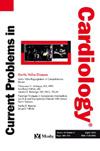Number of beats of nonsustained supraventricular and ventricular tachycardias according to fibonacci sequence
IF 3.3
3区 医学
Q2 CARDIAC & CARDIOVASCULAR SYSTEMS
引用次数: 0
Abstract
Myriads of phenomena in inanimate and animate Nature conform to the Fibonacci sequence and Golden rule. Hundred patients, aged 60.39±13.96 SD (28-92) 53 female, who underwent AEM and had ≥1 bout(s) of NSVT and/or NVT, were analyzed, according to whether the number of beats in these arrhythmias, conformed to the Fibonacci sequence. There was no difference in age, gender, risk factors, and cardiovascular/cerebrovascular pathologies, of the ∼30 %, whose arrhythmias conformed to the Fibonacci sequence, and the remainder 70 %. There is a need to explore the reproducibility of this phenomenon, and its diagnostic and prognostic role in the management of patients.
根据斐波那契数列测定非持续性室上性心动过速和室性心动过速的次数
无生命和有生命的自然界中无数的现象都符合斐波那契数列和黄金法则。对100例(年龄60.39±13.96 SD(28-92))例(53名女性)行AEM且非室速和/或非室速≥1次(s)的患者进行分析,根据这些心律失常的心跳次数是否符合斐波那契序列。30%的心律失常符合斐波那契序列,其余70%的心律失常符合斐波那契序列,在年龄、性别、危险因素和心脑血管病理方面没有差异。有必要探讨这种现象的可重复性,以及它在患者管理中的诊断和预后作用。
本文章由计算机程序翻译,如有差异,请以英文原文为准。
求助全文
约1分钟内获得全文
求助全文
来源期刊

Current Problems in Cardiology
医学-心血管系统
CiteScore
4.80
自引率
2.40%
发文量
392
审稿时长
6 days
期刊介绍:
Under the editorial leadership of noted cardiologist Dr. Hector O. Ventura, Current Problems in Cardiology provides focused, comprehensive coverage of important clinical topics in cardiology. Each monthly issues, addresses a selected clinical problem or condition, including pathophysiology, invasive and noninvasive diagnosis, drug therapy, surgical management, and rehabilitation; or explores the clinical applications of a diagnostic modality or a particular category of drugs. Critical commentary from the distinguished editorial board accompanies each monograph, providing readers with additional insights. An extensive bibliography in each issue saves hours of library research.
 求助内容:
求助内容: 应助结果提醒方式:
应助结果提醒方式:


